Related Research Articles
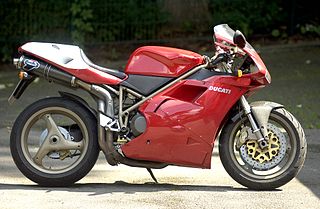
The Ducati 916 is a fully faired sport bike made by Ducati from 1994 to 1998. Featuring a 916 cc (56 cu in) fuel injected, 4-valve, desmo, liquid-cooled, 90° V-twin engine in a trellis frame with a single-sided swingarm and USD forks, the 916 is frequently cited as one of the most beautiful motorcycles ever.

Universal Japanese Motorcycle (UJM) is a US motorcycling media term for a general-purpose style of Japanese standard motorcycle that revolutionized the industry and made motorcycling in America more accessible during the 1970s and 1980s. By around 1990 its popularity began to wane as the market fragmented into more specialized designs.

The Kawasaki Ninja ZX-10R is a motorcycle in the Ninja sport bike series from the Japanese manufacturer Kawasaki, the successor to the Ninja ZX-9R. It was originally released in 2004 and has been updated and revised throughout the years. It combines an ultra-narrow chassis, low weight, and radial brakes. In 2004 and 2005 the ZX-10R won Best Superbike from Cycle World magazine, and the international Masterbike competition.

A sportbike, or sports bike, is a motorcycle optimized for speed, acceleration, braking, and cornering on paved roads, typically at the expense of comfort and fuel economy by comparison with other motorcycles. Soichiro Honda wrote in the owner's manual of the 1959 Honda CB92 Benly Super Sport that, "Primarily, essentials of the motorcycle consists in the speed and the thrill," while Cycle World's Kevin Cameron says that, "A sportbike is a motorcycle whose enjoyment consists mainly from its ability to perform on all types of paved highway – its cornering ability, its handling, its thrilling acceleration and braking power, even its speed."
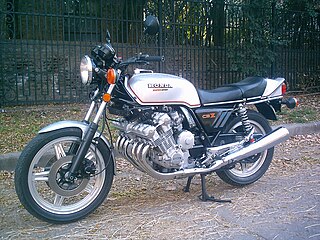
The Honda CBX sports motorcycle was manufactured by Honda from 1978 to 1982. With a 1047cc inline six-cylinder engine producing 105 bhp (78 kW), it was the flagship of the Honda range. The CBX was well-received by the press, but was outsold by its sibling introduced in late 1979, the Honda CB900F.

The Aprilia RSV4 is a super bike manufactured by Aprilia. The RSV4 is Aprilia's flagship model. Aprilia offers two models of the bike: the RSV4 Factory and RSV4 R. For 2016 it is offered in two models the RSV4 RR and the limited-edition RSV4 RF. The 2016 updated bike was made to take advantage of and comply with that year's Superbike rules which allow fewer modifications for production bikes. It has more power, is lighter, and has improved handling and electronics.
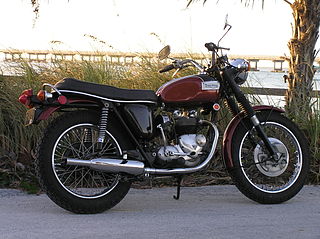
The Triumph Tiger Daytona is a motorcycle made by Triumph from 1967 to 1974.

Cycle was an American motorcycling enthusiast magazine, published from the early 1950s through the early 1990s. During its heyday, in the 1970s and 1980s, it had a circulation of more than 500,000 and was headquartered in Westlake Village, California, near the canyon roads of the Santa Monica Mountains, where Cycle's editors frequently road tested and photographed test bikes.
Erik Buell Racing (EBR) is an American motorcycle sport company which produces street and racing motorcycles, based in East Troy, Wisconsin, USA. The business entered receivership in April 2015. After two previous attempts, the business remnants were sold in January 2016 to Liquid Asset Partners (LAP), an American organization specializing in the purchase and liquidation of failed businesses. Liquid Asset Partners kept the company intact and motorcycle production resumed on March 1, 2016, the first new model rolling out on March 17, 2016.
The Honda CB900F is a Honda motorcycle made in two iterations which appeared some twenty years apart. Both generations of the CB900F are straight four-cylinder four-stroke 900 cc (55 cu in) roadsters.
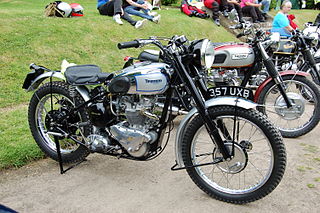
The Triumph sprung hub is a motorcycle suspension unit contained within a rear wheel hub. It was designed by Triumph engineer Edward Turner to give Triumph's existing rigid frames the option of rear suspension. It was one of the first motorcycle components to have a safety warning cast into its housing.
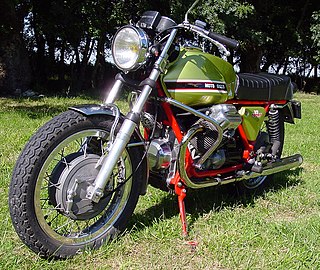
Lino Tonti was an Italian motorcycle engineer known for designing a number of sport and racing motorcycles in the 1950s and 1960s, and for creating his signature 'Tonti frame' for Moto Guzzi's 1971 V7 Sport, setting his stamp on all Moto Guzzis since.

Steven Lynn Thompson is an author, magazine journalist, historian of technology and former motorcycle racer.
Forced induction in motorcycles is the application of forced induction to a motorcycle engine. Special automotive engineering and human factors considerations exist for the application of forced induction with motorcycles, compared to other forms of motorized transportation.

The Kawasaki Ninja H2 is a "supercharged supersport" class motorcycle in the Ninja sportbike series, manufactured by Kawasaki Heavy Industries, featuring a variable-speed centrifugal-type supercharger. The track-only variant is called Ninja H2R, and it is the fastest and most powerful production motorcycle on the market; it produces a maximum of 310 horsepower (230 kW) and 326 horsepower (243 kW) with ram air. The H2R has 50% more power than the fastest street-legal motorcycles, while the street-legal Ninja H2 has a lower power output of 200 hp (150 kW)–210 hp (160 kW) with ram air.

Silver Bird was a motorcycle land-speed record setting streamliner motorcycle. It was powered by two motors delivering 240 horsepower (180 kW). It was the first motorcycle to set a speed record over 300 miles per hour (480 km/h), when ridden by Don Vesco at the Bonneville Speedway in 1975.

Motorcyclewheels are made to cope with radial and axial forces. They also provide a way of mounting other critical components such as the brakes, final drive and suspension. Wheels, and anything directly connected to them, are considered to be unsprung mass. Traditionally motorcycles used wire-spoked wheels with inner tubes and pneumatic tyres. Although cast wheels were first used on a motorcycle in 1927, it would not be until the 1970s that mainstream manufacturers would start to introduce cast wheels on their roadgoing motorcycles. Spoked wheels are usually made using steel spokes with steel or aluminium rims. Cast wheels are predominantly made from an aluminium-alloy, but can also be made from more-exotic materials, such as magnesium content alloy or carbon fibre.
Tire lettering is the practice of putting, or drawing visible letters on the sidewall of an automobile's tires. In modern usage, the lettering is often big car brands or tire brands names, with custom lettering being a much smaller niche of that. It can also refer to other after market customizations to the side wall of the tire, such as the "white wall tire" look, but any color of the spectrum is available now, including "rainbow wall tires".
References
- ↑ "Book jacket", Top Dead Center 2, Motorbooks, 2009
- ↑ Dean Adams (1994), The AMASuperbike.com Interview: Kevin Cameron, Superbike Planet, archived from the original on 2013-06-01, retrieved 2013-09-10
- 1 2 CW IndyGP Seminar Panelist: Kevin Cameron, September 10, 2008, retrieved 2013-09-10
- 1 2 Thomas W. Day (2008), Kevin Cameron Interview Text, archived from the original on 2013-09-10, retrieved 2013-09-10